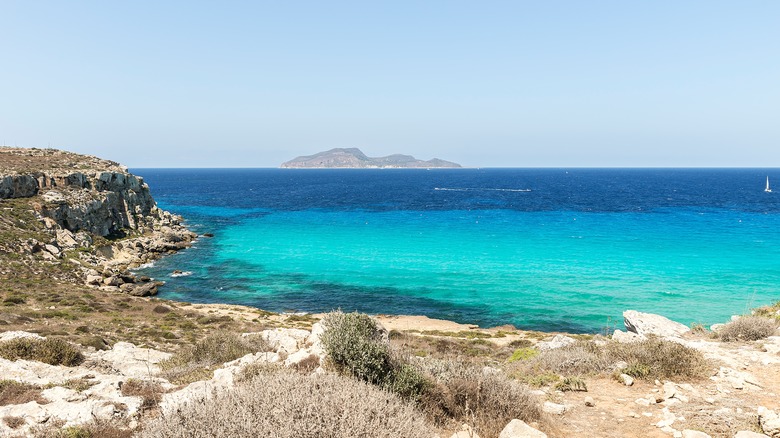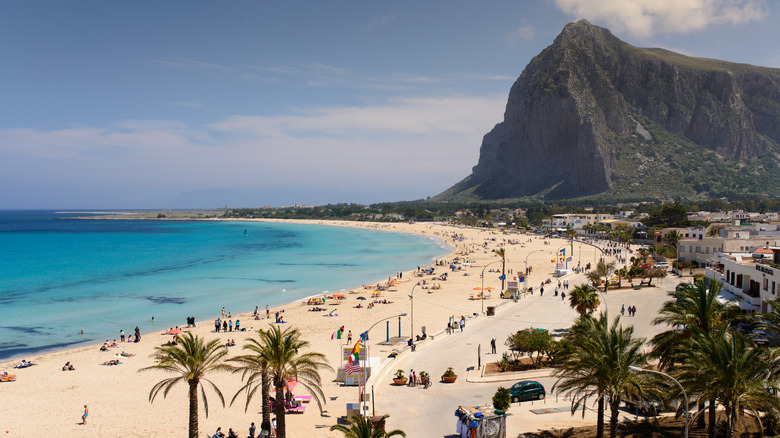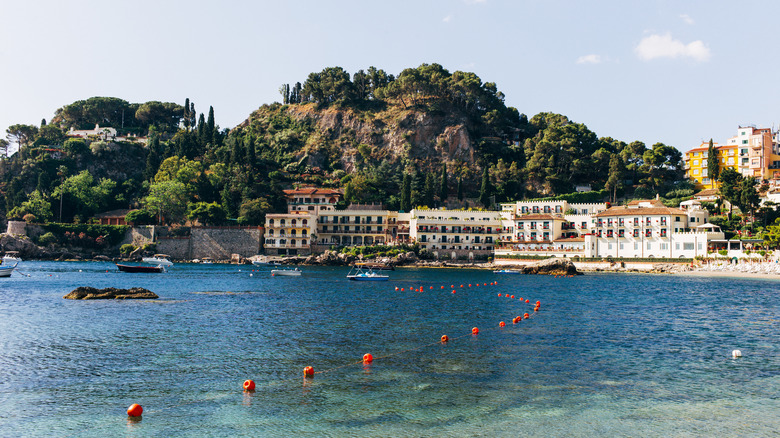Sicily's Best Beaches And How To Find Them
The largest island in Italy is famous for a plethora of reasons, though visitors should also consider some of Italy's beautiful islands that don't get enough attention. For starters, who can ignore Sicily's food, with delights like arancini (fried balls or rice and cheese), caponata (a hearty dish made with eggplants and tomatoes), and the dessert cake cassata. Sicily is also rich in history, a land that was controlled by Romans, Greeks, and other European forces. The imprint of those varying cultures endures, evident throughout the island in the architecture, cuisine, and way of life. Mount Etna is also in Sicily, possibly the most famous volcano in the nation. It remains very much active (it erupted in 2024), and has a bucket-list hike which is a thrill-seekers paradise.
The Valley of the Temples is a Unesco World Heritage Site, a complex of temples built for the era's gods, and a key historical destination on the island. And then, of course, travelers will be attracted by Sicily's sublime beaches strung along the island's hundreds of miles of coastline. In reality, there are enough beaches around the island that you wouldn't be able to enjoy all of them during a two-week trip. That's why many people, from Sicilians to visiting tourists, might just stick to their favorite, strands of sand that are not to be missed. We trawled through blogs and tourism sites and uncovered some of Sicily's standout gems, beaches that you really should visit during your next vacation on the island.
Bue Marino
Part of the Egadi archipelago, Favignana is a small island that sits just off the west coast of Sicily and has a winding, jagged coastline that gives it a rugged form. It's along this shore that travelers can find Bue Marino, a cove with white cliffs and hypnotic blue water. The beach, on the east of the island, is a study in contrasts, with the deep, never-ending blue a stark counterpoint to the blinding white rock. It's the kind of place that almost looks like a fantasy.
The beach resides on the edge of an old quarry of tuff, a rock derived from volcanic ash and dust. Expect water that is deep, so it's not the best beach for children, or novice swimmers, and access to the water is via grooves in the rock down to the sea. Bue Marino, which translates to "sea ox" in English, gets its name from the monk seals that sometimes frequent the waters there. Getting on the island is relatively straightforward, with two options open to travelers. The most cost-effective method is by boat, with departures from Marsala and Trapani on Sicily, and the quickest transfer taking only 30 minutes. There are also flights from Palermo and Trapani but expect to pay significantly more than if arriving by boat. From the main town of Favignana, beach bunnies can make the three-mile trip to the beach on a scooter, bicycle, or by foot.
Cala Dogana
Another Egadi island, Levanzo lives north of Favignana. Arrival is via ferry, with scheduled routes to Trapani, as well as Favignana and the other Egadi isle of Marettimo, an Italian island paradise with bright blue water and whitewashed buildings. The action, if you can call it that, on this quiet island, centers around the main village in the south, where the ferries dock. This is where to find guesthouses, places to get a bite, and even some caves.
It's also the setting for Cala Dogana, a sandy beach right by the heart of the village. This is a simple, no-frills beach, one without tons of amenities, or heaps of stalls selling fried snacks or drinks with umbrellas in them. What travelers will find is a stretch of soft sand that's only a few hundred feet in length, yielding to glorious, clear, calm turquoise seas that gradually descend to deeper waters. White rock lines the end of the beach, adding a visually striking element to the vista, and you might also see a few boats bobbing in the gentle swell.
Calamosche
In the south of Sicily, not far from the very southernmost tip of the island, this beach is tucked between headlands. It's part of a set within the Riserva di Vendicari, a nature reserve that has a number of beaches, as well as places to go birdwatching, with flamingos and herons on display, and admire wild nature. Calamosche is considered the jewel of the beaches in the reserve, with two fingers of rock protruding out from either end, ensuring that the water is calm, and protected from large waves.
This ensures that the water, clear and tranquil, is perfect for swimmers of all ages, and is a fine spot for snorkeling and just paddling about in the shallows. It's not a large beach, about 700 feet of shoreline, but the dependable conditions make it a surefire hit. Parking is less than a mile away, with access to the beach requiring that visitors travel the final stretch to the beach itself on foot.
Cala Rossa
Another beach on Favignana, Cala Rosso can easily be combined with Bue Marino, which is about 15 minutes away via simple pathways on the arid ground. As with Bue Marino, the contrast of the water with what is onshore is the appeal of this fine beach. Cala Rossa doesn't have white cliffs but promises visitors sheer, angular rocks that contrast with the vivid blues of the water. The rocks, appearing in vertical slabs that can look like towers of gray Jenga come to life, are made of calcarenite and were once quarried.
A type of limestone, calcarenite combines coral, fossilized animals, and shells that had been pressed by great forces to make them into hard rock. Visitors looking at the rocky walls, which look both formidable and delicately layered, might marvel at how they seem to dramatically frame the water as if presenting the blues like a work of art. Getting to Cala Rossa, which is on the north coast of the island, involves a journey of a couple of miles or so, which can be done by scooter or bicycle from the main village.
Caletta del Bue Marino
Not to be mistaken for Bue Marino on Favignana, this small, pebbly cove is on the island of Sicily itself. The beach is close to the northwestern tip of the island, perhaps most easily reached from the town of Trapani, or San Vito lo Capo. The beach is a fine section of coastline, with little rocks that make a pleasing, soothing, crunching sound when the incoming gentle waves make them roll on one another.
What sets this beach, which isn't big by any accepted metric, is the presence of sea caves. Behind the beach, a wall of cliffs is pockmarked with small openings, and there are caves within. Erosion has carved out a variety of interesting contours on the cliff wall, and the layers of rock are compacted with such artistic shapes, that the overall effect is quite hypnotic. There are even underwater caves that travelers can explore if they strap on a snorkel mask, or go for a dive.
Guidaloca
This picturesque cove finds its home in the northwest of Sicily, between the towns of Castellammare del Golfo and Scopello. Tourists can enjoy serenity by the sea thanks to the natural shape of the cove, with forested headlands bookending the two sides, creating a buffer from the open sea's waves. This is definitely a pretty spot with a gentle sweep of sand gently merging into the calm turquoise shallows. In summer, this is a popular refuge for families looking for some tranquil beach action and pleasant swimming.
Snorkelers will also like the calm conditions, allowing for easy exploration of the rocky coastline and the aquatic creatures that live within. Away from the water, visitors can find a number of hiking trails that come with excellent views of the sea or lead to the historical sights in Castellammare del Golfo and the charming, quintessential small Italian village feel of Scopello. You'll need your own set of wheels to visit this beach, and it takes about 45 minutes to reach it by car from Palermo.
Isola Bella
On a map, Isola Bella, a tiny speck of an island with a winding coastline, sits just off the coast of Sicily. Located right by Taormina, it is an isle, but at low tide, a slender strand of beach appears, linking the two, and visitors can walk to it at that time. The island has a rich, interesting history, donated to the people of Taormina by the King of Sicily in the early 1800s.
It was purchased by an English aristocrat at the end of that century, who built a house there and also planted blooms and greenery around Isola Bella. Since then, the island has changed hands on a few occasions, though today it's designated as a naturalist museum, which the public can visit. It's a rocky island, almost like a fortress in its shape and form, and while the craggy island doesn't have any beaches, the strand connecting it and Taormina is an attractive spot to unwind and take in the scenery.
Lungomare di Cefalù
The city of Cefalù is a cheaper, calmer alternative to the crowded Amalfi Coast. It has plenty to see, from a Moorish cathedral to historical ruins that date to the days of the Greeks and the Normans. It also has the Rocca di Cefalù, a sheer-faced mountain that is the dominating presence standing sentry over the city — hike to the top and you can enjoy some breathtaking views of the town and the sea. And adding even more luster to this city on the north coast of Sicily is the main long beach.
The beach stretches for miles, connecting the old historic part of Cefalù to the newer end of the city. It's a hugely popular spot, especially in the peak of summer, thanks to easy access and the shallow waters that make it family-friendly. For non-beachgoers, it's also a pleasant place to take a stroll, as it is backed by a promenade with sea and mountain views, and also shops, places to eat, and a good selection of accommodation options.
Mondello
Situated north of the center of Palermo, this village is a short hop from Sicily's main city and has a gorgeous beach. Visitors can get there by taxi, or for the more budget-conscious, there is a bus service to the beach, though it tends to get very crowded during the summer. The more adventurous might also use an electric scooter, or cycle the distance — it's about nine miles from Palermo's main train station to the beach.
The sand itself unfurls along a lengthy section of shoreline, with clumps of rocky hills at one end, and calm turquoise water in front. The beach is split into two sections. One is free and gets crowded very quickly. For visitors not used to the throngs that mass on a European beach in the summer, this can be quite disorientating. The other, larger part is known as the lido and requires that visitors pay to use it. It is much more orderly than the free section as a result, and guests need to pay for the use of beach umbrellas and sun loungers. This also fills quickly during the season, so reservations are recommended.
Riserva dello Zingaro
Located in the west of the island, between Scopello and San Vito lo Capo, the Riserva Naturale Orientata dello Zingaro, to give it its full name, is a place of wild beauty. It was designated as the first nature reserve on the island and has a wide range of terrains and sites to visit. There are no roads within it, but what visitors will encounter are olive trees, foxes roaming around, and seagulls soaring overhead. There are also caves, both inland and by the sea, walking paths that crisscross the reserve, and even simple shelters where adventurers can slumber overnight.
Fans of the sand will also find seven beaches in the reserve, and of them, Cala Capreria is arguably the finest. It's certainly one of the easiest to access, the nearest to the southern entry point of the reserve. The cove can be reached by walking for about 20 minutes from the southern entrance parking lot, most of the journey downhill. Upon arrival, visitors will find a secluded cove where forested, rocky slopes rise up on either side and behind. The beach is small — it would take only a few minutes to walk the entire length. But the intimacy of it, and the combination of bright white pebbles, shallow turquoise water, and craggy, eroded, rust-colored rock faces make for a beautiful experience.
Riserva Naturale Orientata di Torre Salsa
Visitors to this section of southwestern Sicily will find oodles of wild, rugged nature spread across 760 hectares. Travelers who venture to the reserve will find a variety of environments throughout, from wetlands to coastal dunes, grass fields, and even cliffs that add some vertical heft to the landscape. There are also beaches all along the miles of coastline, ribbons of soft sand that yield to the azure depths of the Mediterranean Sea. Fans of wildlife might be lucky enough to spot peregrine falcons, wading birds, and ravens among the teeming avian life, while porcupines and turtles are also found there.
The reserve takes its name from the tower located on a hill in the northern part. Of the beaches, Libera is the easiest one to reach from the car park, a broad slice of sand and sea. There is also a nudist beach in the reserve, perfect for the kind of traveler who might stop by the best nude beaches in the Caribbean.
San Vito lo Capo
If this seaside town feels like it's at the end of the world, that's because, physically, it might feel like it is. San Vito lo Capo sits on the edge of a peninsula on the northwestern tip of the island, and looking due north, visitors will see nothing but sea all the way to the horizon. The main beach takes advantage of that fine setting, opening up onto fine, clear water.
What makes this destination even more special is Monte Monaco, a towering peak that dominates the views from all points on the sand. But that shouldn't take away from the beauty of the beach itself. It unravels along a long, curling sweep, almost a perfect crescent shape, and has palm trees dotted around the back. Stretching for almost two miles, it does get busy in the summer, not only for its fine setting but also because the water looks like something out of the Caribbean. Away from the water, the town has lots of eateries, with seafood being a local specialty.
Scala dei Turchi
This is another beach that looks like it was crafted by some higher power, such is the theatrical, dramatic combination of its natural attributes. The name of the beach translates to the ladder or staircase of the Turks, thus named for the Saracen seafarers (the locals called them Turks) who frequented the area to raid the nearby villages in the 16th century. The beach is in the Valley of the Temples region, and its pure white marl cliffs, shaped over eons by the erosive forces of wind and water, look sculpted by some giant being.
The cliffs almost look like mammoth waves frozen on land, curving and sensuous, not harsh and rigid like traditional cliffs. Made of limestone and clay, the cliffs are so unique in color and form, that the beach at times becomes overrun with tourists. It's also a popular backdrop for TV and cinema filming, starring in several Italian productions. Despite all this, it's worth making the effort to sink your toes in the sand of Scala dei Turchi, just for the sheer spectacle of it all. Travelers will find it close to the Valley of the Temples, Agrigento, or Realmont.
Methodology
From north to south, east to west, there is no shortage of beaches in Sicily. To narrow down the list, we looked at blogs like Italy Magazine for some options. We also decided to include islands that are close to Sicily — like Favignana and Levanzo — but chose to exclude the Aeolian Islands (one of which has gorgeous black-sand beaches) and Pantelleria, which are a little further away and tend to be destinations where visitors overnight. Once we finalized the choices, we researched each beach in depth using travel blogs like We are Palermo and tourism pages. That way, we were able to get details not only on the beaches but also on the easiest way to get to them.














